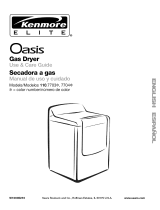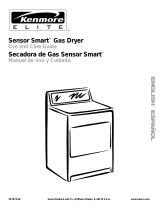
TABLEOF CONTENTS
WARRANTY ..................................................................................... 2
DRYER SAFETY .............................................................................. 3
INSTALLATION INSTRUCTIONS .................................................. 4
Tools and Parts ............................................................................ 4
Location Requirements ............................................................... 5
Electrical Requirements ................................................................ 6
Gas Supply Requirements ........................................................... 6
Venting Requirements .................................................................. 7
Plan Vent System ......................................................................... 8
Install Vent System ....................................................................... 9
Install Leveling Legs .................................................................. 10
Make Gas Connection ............................................................... 10
Connect Vent ............................................................................. 10
Connect Inlet Hose .................................................................... 11
Level Dryer ................................................................................. 11
Reverse Door Swing .................................................................. 11
Complete Installation ................................................................. 13
DRYER USE ................................................................................. 14
Starting Your Dryer .................................................................... 14
Stopping, Pausing or Restarting ............................................... 15
Drying and Cycle Tips ............................................................... 15
Status Lights .............................................................................. 16
Cycles ........................................................................................ 16
Modifiers .................................................................................... 17
Options ...................................................................................... 18
Cycle Signal ............................................................................... 18
Changing Cycles, Modifiers and Options ................................. 19
Dryer Rack ................................................................................. 19
DRYER CARE .............................................................................. 20
Cleaning the Dryer Location ...................................................... 20
Cleaning the Lint Screen ........................................................... 20
Cleaning the Dryer Interior ........................................................ 20
Removing Accumulated Lint ..................................................... 21
Water Inlet Hoses ...................................................................... 21
Vacation, Storage and Moving Care ......................................... 21
Changing the Drum Light .......................................................... 21
TROUBLESHOOTING .................................................................. 22
PROTECTION AGREEMENTS .................................................... 23
SERVICE NUMBERS ............................................... BACK COVER
KENMORE ELITE®
APPLIANCE WARRANTY
ONE YEAR LIMITED WARRANTY
When installed, operated and maintained according to all
instructions supplied with the product, if this appliance fails due
to a defect in material or workmanship within one year from the
date of purchase, call 1-800-4-MY-HOME ®to arrange for free
repair.
If this appliance is used for other than private family purposes,
this warranty applies for only 90 days from the date of purchase.
THIS WARRANTY COVERS ONLY DEFECTS IN MATERIAL
AND WORKMANSHIP. SEARS WILL NOT PAY FOR:
1. Expendable items that can wear out from normal use,
including but not limited to filters, belts, light bulbs, and bags.
2. A service technician to instruct the user in correct product
installation, operation or maintenance.
3. A service technician to clean or maintain this product.
4. Damage to or failure of this product if it is not installed,
operated or maintained according to all instructions supplied
with the product.
5. Damage to or failure of this product resulting from accident,
abuse, misuse or use for other than its intended purpose.
6. Damage to or failure of this product caused by the use of
detergents, cleaners, chemicals or utensils other than those
recommended in all instructions supplied with the product.
7. Damage to or failure of parts or systems resulting from
unauthorized modifications made to this product.
DISCLAIMER OF IMPLIED WARRANTIES; LIMITATION OF
REMEDIES
Customer's sole and exclusive remedy under this limited
warranty shall be product repair as provided herein. Implied
warranties, including warranties of merchantability or fitness for a
particular purpose, are limited to one year or the shortest period
allowed by law. Sears shall not be liable for incidental or
consequential damages. Some states and provinces do not allow
the exclusion or limitation of incidental or consequential
damages, or limitations on the duration of implied warranties of
merchantability or fitness, so these exclusions or limitations may
not apply to you.
This warranty applies only while this appliance is used in the
United States and Canada.
This warranty gives you specific legal rights, and you may also
have other rights which vary from state to state.
Sears, Roebuck and Co.
Dept. 817WA, Hoffman Estates, IL 60179
Sears Canada Inc.
Toronto, Ontario, Canada M5B 2B8
2





















